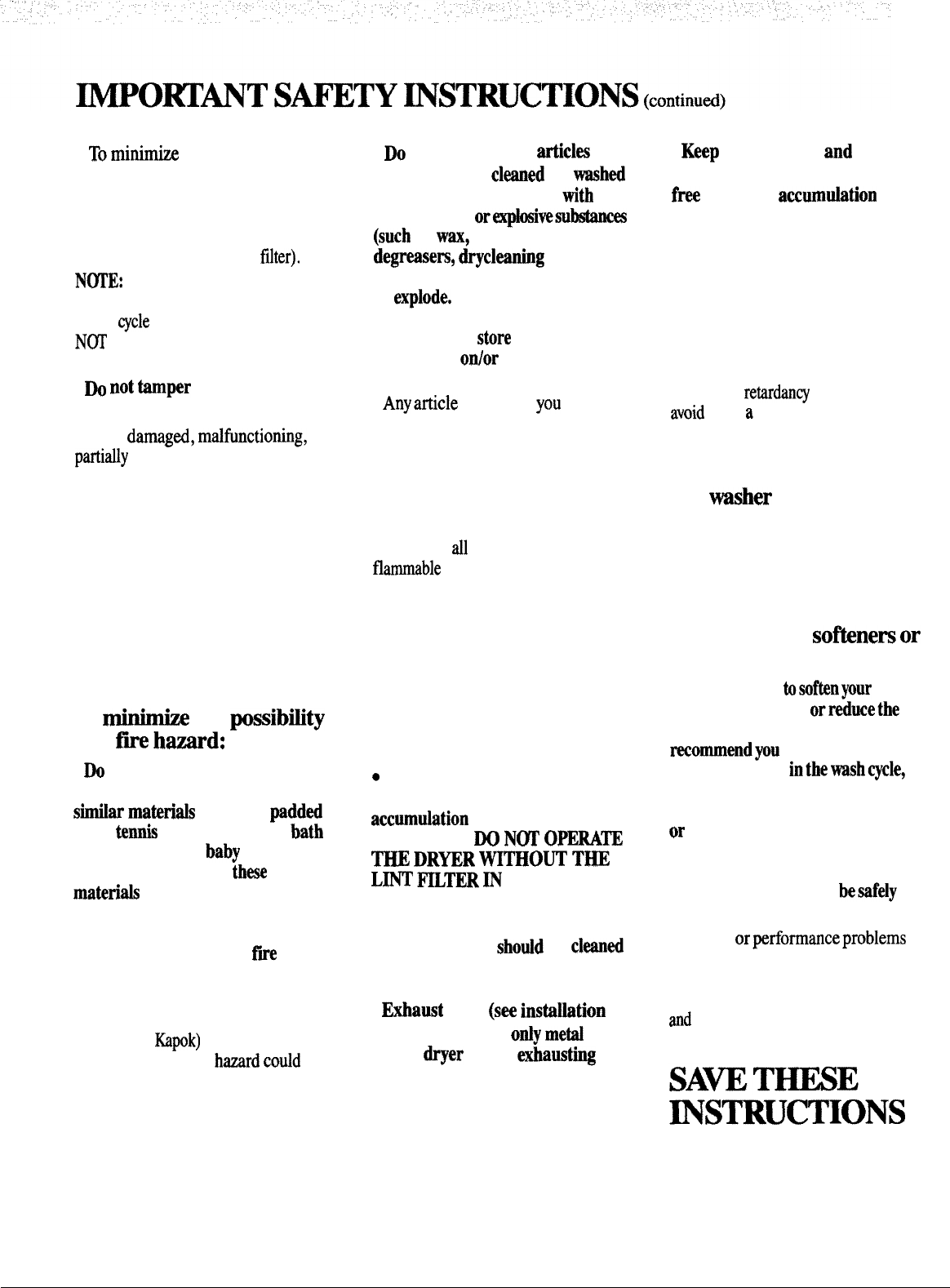
●
Tomi_
the possibility
of electric shock, unplug this
appliance from the power supply
before attempting any maintenance
or cleaning (except the removal and
cleaning of the dryer lint
fflter).
N~E:
Pushing the washer cycle
selector knob in or turning the
dryer
cycle
selector to OFF does
N~
disconnect the appliance
from the power supply.
●
m
not
tamper
with
controls.
●
Do not operate this appliance
if it is
damagd,
malfunctiotig,
partidy disassembled, or has
missing or broken parts, including
a damaged cord or plug.
●
Never climb on or stand on the
washer or dryer top.
●
Do not wash or dry fiberglass
articles in your appliance. Skin
irritation could result from the
remaining particles that may be
picked up by clothing during
subsequent use of the appliance.
To
~e
the
possibfity
of a
fw
h-d:
●
DO
not use heat
to dry articles
containing rubber, plastic, or
SMM
materhds
(such as
paddti
bras,
tennis
shoes, galoshes,
bath
mats, rugs, bibs,
b~by
pants,
plastic bags, etc.) as
these
materhds
may melt or burn.
Also, some rubber materials,
when heated, can under certain
circumstances produce
fire
by
spontaneous combustion.
●
Garments labeled “Dry Away
From Heat”
(such as life jackets
containing
tipok) must not be put
in your dryer-fire
hmrd
codd
result.
●
DO
not wash
or dry
articles
that have been
clwed
in,
wushed
in, soaked in, or spotted
tith
combustible
or~hivesu~
(such
as
WU,
paint, gasoline,
degmsers,
drycleaning
solvents,
kerosene, etc.) which may ignite
or e~lode. Do not add these
substances to the wash water, and
do not use or
store
these
substances
odor
around your
appliance during operation.
●
Any
article
on
which
you
have
used a cleaning solvent, or which
contains flammable materials
(such as cleaning cloths, mops,
towels used in beauty salons,
restaurants or barbershops, etc.)
must not be placed in or near the
dryer until
dl
traces of these
fl
ammable
liquids or solids and
their fumes have been removed.
There are many highly flammable
items used in homes such as:
acetone, denatured alcohol,
gasoline, kerosene, some household
cleaners, some spot removers,
turpentines, waxes, wax removers
and products containing petroleum
distillates.
Q
Clean the dryer lint filter
before each load to prevent lint
accurmdation
inside the dryer or
in the room.
DO
N~
OPERA~
=
DR~R
W~O~
T~
L~
~TER
~
PLACE.
●
The interior of the machine
and the exhaust duct connection
inside the dryer shodd he
claed
periodically by a qualified
individual.
●
~aust
duct
(s~
ins~~~tion
instructions). Use
o~y
meti
duct
inside
dryer
or for
*usting
dryer to the outside.
●
Keep
area around
and
underneath your appliance
free
from the
accum~ation
of
combustible materials, such as
lint, paper, rags, chemicals, etc.
●
Do not store items that may
burn or melt (such as clothing,
paper material, plastics or plastic
containers, etc.) on top of the dryer
during operation.
●
The laundry process can reduce
the flame
retardancy
of fabrics. To
avoid
such
a
result, the garment
manufacturer’s care instructions
should be followed very carefully.
For
wsher
operation
●
Do not leave washer lid up during
cycle. This will stop the spin action
and prevent completion of the cycle.
Dryer-applied
fabric
sofinersor
-
anti-static conditioners
You may wish
tosoftenyour
laundered fabrics
orreducethe
static electricity in them. We
recornmendyou
use either a
fabric softener
inthewashcycle,
according to the manufacturer’s
instructions for those products,
or
try a dryer-added product for
which the manufacturer gives
written assurance on the package
that their product can
besafdy
used in your dryer.
Service
orperformanceproblems
caused by the use of these products
are the responsibility of the
manufacturers of those products
and
are not covered by the warranty
of this appliance.
~S~UC~ONS
-
4


















